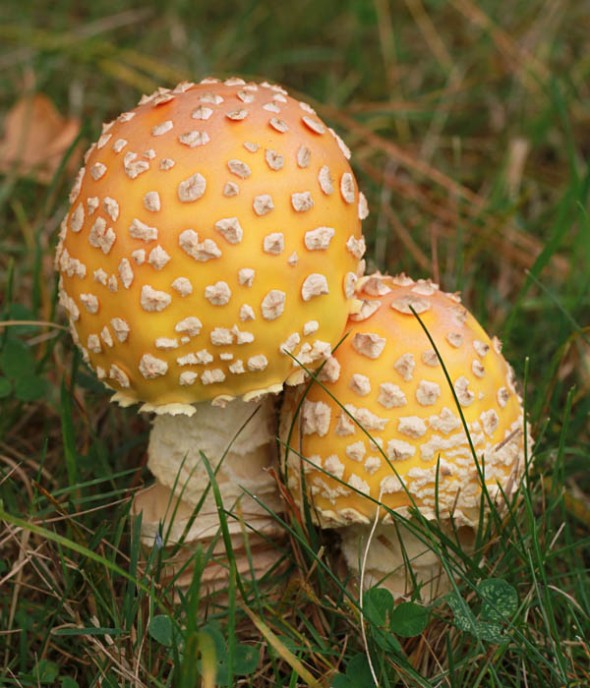Yellow-orange Fly Agaric Mushroom
 The Yellow-orange Fly Agaric (Amanita muscaria var. formosa) is common in New England, especially where conifers grow. Out West this mushroom is often a bright red color, but in the East it’s typically orange/yellow. When certain gilled mushrooms, including many Amanita species, first form, they are encased in a membrane called a “universal veil.” As the mushroom enlarges and matures, the veil ruptures, with remnants of it remaining on the mushroom’s cap. Fly Agaric fungi got their name from the custom of placing little pieces of the mushroom in milk to attract flies. The flies supposedly become inebriated and crash into walls and die. This mushroom is somewhat poisonous (as are many Amanita species) and hallucinogenic when consumed by humans. The toxins affect the part of the brain that is responsible for fear, turning off the fear emotion. Vikings, who had a reputation for fierceness, are said to have ingested this mushroom prior to invading a village.
The Yellow-orange Fly Agaric (Amanita muscaria var. formosa) is common in New England, especially where conifers grow. Out West this mushroom is often a bright red color, but in the East it’s typically orange/yellow. When certain gilled mushrooms, including many Amanita species, first form, they are encased in a membrane called a “universal veil.” As the mushroom enlarges and matures, the veil ruptures, with remnants of it remaining on the mushroom’s cap. Fly Agaric fungi got their name from the custom of placing little pieces of the mushroom in milk to attract flies. The flies supposedly become inebriated and crash into walls and die. This mushroom is somewhat poisonous (as are many Amanita species) and hallucinogenic when consumed by humans. The toxins affect the part of the brain that is responsible for fear, turning off the fear emotion. Vikings, who had a reputation for fierceness, are said to have ingested this mushroom prior to invading a village.


















I believe this is also the mushroom that reindeer consume in the Arctic. People drink the urine of these reindeer to get high.
October 16, 2012 at 12:37 pm
Yes, Rob, apparently the body (human, reindeer or any other) metabolizes the toxins but the hallucinogens pass through unchanged. People did drink each others’ urine as well as that of animals that consumed this mushroom…don’t ask me how they collected reindeer urine!
October 16, 2012 at 1:03 pm
Mary, might you know the reason for oak leaves falling early this year when still green, beginning in late Sept. And the stems are not attached to the leaf, just the leaf. And they are still on the ground, green, haven’t turned brown yet after 2-3 weeks. I’ve seen this on several trails I’ve walked recently.
Sincerely, Sandy Chivers
a
October 16, 2012 at 1:22 pm
Hi Sandy,
I’m afraid I’m at a total loss as to an explanation for this phenomenon. I haven’t actually observed it here in the woods around my home in central Vermont, but it could well be happening elsewhere. If I come across an explanation, I will certainly share it with you.
October 16, 2012 at 3:30 pm
I quibble with your statement that these are somewhat poisonous, as are many Amanita species. Some Amanitas are extremely poisonous, enough to cause human deaths. That’s interesting about the Vikings.
October 16, 2012 at 11:38 pm
Hi Jean,
Yes, you’re right, some/many Amanitas are deathly poisonous, but this particular species, according to all I have read, is not, though I’m sure if consumed in large enough quantities, it could be. From now on I will try to stress even more than I did when a mushroom or plant should not be eaten. I did think I made that pretty clear, but apparently not clear enough! Thanks.
October 17, 2012 at 1:00 am
Hi Mary,
Hate to be a party-pooper but there is in fact no factual information indicating that the Vikings partook of Amanita mushrooms when they went so-called ‘berserkergang’. This speculative theory is loosely based on a hypothesis from the 1700s, where it was somehow assumed that since Northern shamans (the Sami peoples of Scandinavia as well as Siberian shaman) made ritualistic use of Amanita muscaria, then perhaps mushroom use could also explain the bizarre behavior of the Norse Berserker warriors. There is, however, nothing in contemporary Norse writing to confirm this. However, this ‘theory’ is so often repeated, and admittedly fascinating, that it will probably never disappear …
Cheers!
Brian
October 25, 2012 at 10:32 am
Thank you so much, Brian, for letting me and readers know of the fallacy of my comment about Vikings! I thought I had gotten that fact from a reliable source, but obviously had not. I really appreciate your clarification! Mary
October 25, 2012 at 12:29 pm
I have collected 250 grams of dried Amanita muscaria but never had the courage to try them. I read that if I make a tea at 190 degrees and steep 4 grams per cup, that will be ok..any thoughts on that ? Wow that a lot of cups hahaha I all so have 6 oz of stinging nettle which makes a lovely tea…all from the Tobique river basin in NB,Canada
December 3, 2018 at 2:50 pm
My thoughts are to avoid it completely, although I know fatality reports are few and far between, and parboiling does weaken the toxicity…but I’m not a gambling woman.
December 3, 2018 at 4:03 pm